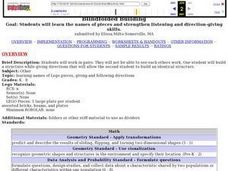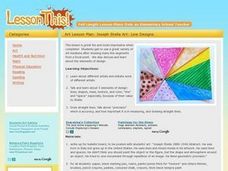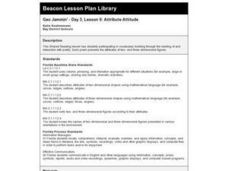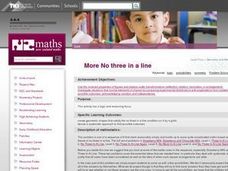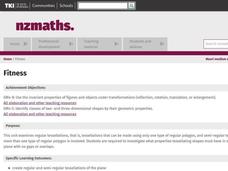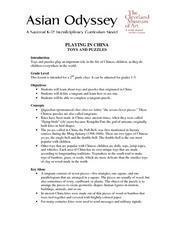Curated OER
What Makes A Face A Face?
High schoolers discuss what enables us to read a face: features, expressions, standards of beauty, age and gender. They discuss what enables us to read motion: repetition, sequence, changes in form and scene.
Curated OER
Identifying Lines of Symmetry
Students calculate the lines of symmetry using polygons. In this geometry instructional activity, students graph, compare and estimate using collected data. They identify different attributes to the polygons based on their sides.
Curated OER
Keith Haring and Graffiti
Students appreciate the art of the artist Keith Haring. They design and implement Keith Haring-like images for a wall mural and explain and experience a project containing many different compenents and processes from beginning to end.
Curated OER
Blindfolded Building
Students build a Lego design and then work with a partner to reproduce that design. They guide the building of the reproduction by description only and then check their work.
Curated OER
Sand Painted Teepees
Second graders create "Sand Painted teepees" using sand, paper, glue, and information about Native American culture in this 2nd grade Art lesson. The lesson includes a vocabulary list, a materials list, a resource link, and a short...
Curated OER
Joseph Stella Art: Line Designs
Students discover the focal point in pictures and create their own images using lines and space. For this art analysis lesson, students create a black dot on a white paper which becomes a focal point for the lines the student will paint...
Curated OER
Narrow It Down
Students participate in a logic activity in which they identify items. In this logic activity, students work in groups as they play a questioning game that is similar to "Twenty Questions." They ask questions and rule out items in a...
Curated OER
Designing a Quilt Pattern
Students create and color a one-patch quilt design based upon a regular hexagon. They examine quilts and photos of quilt designs, read a handout, and complete their quilt design on a worksheet.
Curated OER
Totem Poles -- Storytellers of Long Ago
Third graders discover the main purpose for totem poles was to communicate with others. In groups, they compare and contrast the four types of totem poles and the various symbols used. They write their own stories based off of pictures...
Curated OER
Symmetry with Manipulatives
First graders investigate symmetry in patterns by utilizing unifix cubes. In this pattern lesson, 1st graders practice creating patterns that are perfectly symmetrical no matter which way it's looked at. Students utilize original...
Curated OER
Stained Glass Critter
Students investigate the the origination of stained glass in the 12th century cathedrals.
They practice writing their names in cursive symmetrically. Students also practice how to make a stained glass image.
Curated OER
Measuring Pattern Block Angles
Sixth graders identify various angles by using pattern blocks. For this measurement lesson, 6th graders find out how many degrees are in each of the different angles of the various pattern blocks.
Curated OER
Self Portraits Part 2
Sixth graders explore the concept of Cubist art. In this visual arts lesson, 6th graders examine examples of Pablo Picasso's work and they create self portraits in Cubist style.
Curated OER
2-D Geometry
Third graders are introduced to new vocabulary related to Geometry. As each word is mentioned, they demonstrate the word with their body. In groups, they identify the similarities and differences between each line and angle. To end...
Curated OER
Fractions of a Set
Third graders use fractions to describe part of a set. In this fractions lesson, 3rd graders are introduced to fractions through a book and use pattern blocks to describe a fraction as a part of a set. This lesson includes a scripted...
Curated OER
Geo Jammin' - Day 3, Lesson 9: Attribute Attitude
Second graders read poetry and build their vocabulary through use of the puppet Geo George.
Curated OER
Angles Lesson Plan
Young scholars stud angles, and then play the "What's Your Angle?" game. They complete at least 10 computer generated problems from the Angles Applet.
Curated OER
Distortion Unleashed
Students view examples of man-made structures and create a building that matches the style. Using the internet, they research the style of Frank Lloyd Wright and create plans for creating their own community. They use a painting of...
Curated OER
Squares Have Roots?
Students define a square and connect this information to a square root. In this square root lesson, students make a chart listing square numbers and their roots.
Curated OER
Building Paper Bridges
Learners construct a bridge that can hold 100 pennies. In this math lesson, students evaluate the strength of their bridges. They predict how much weight a bridge can hold based on its design.
Curated OER
More No-Three-In-A-Line
Fourth graders read Mary's problem and make sure that they examine it.
After some discussion, let the class work on the problem in their groups.
They then take turns in putting a picture of their arrangement on the board.
Curated OER
No-Three-In-A-Line Again
Students interpret information and results in context while using words and symbols to generalize patterns. They use symmetry and angle properties of polygons to solve practical problems and identifying invariant properties under...
Curated OER
Fitness
Fourth graders determine how to design regular and semi-regular tessellations of the plane. They develop the ability to demonstrate why a tessellation covers the plane in this series of lessons.
Curated OER
Playing in China
Students create their own Chinese tangrams using in-class direction and prior knowledge in this two-day lesson for the early elementary classroom. Chinese toys are also explored.





